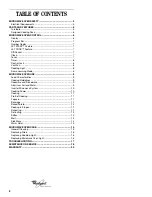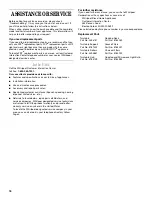
9
Food Characteristics
When microwave cooking, the amount, size and shape, starting
temperature, composition and density of the food affect cooking
results.
Amount of Food
The more food heated at once the longer the cook time. Check
for doneness and add small increments of time if necessary.
Size and Shape
Smaller pieces of food will cook more quickly than larger pieces
and uniformly shaped foods cook more evenly than irregularly
shaped food.
Starting Temperature
Room temperature foods will heat faster than refrigerated foods
and refrigerated foods will heat faster than frozen foods.
Composition and Density
Foods high in fat and sugar will reach a higher temperature and
heat faster than other foods. Heavy, dense foods, such as meat
and potatoes, require a longer cook time than the same size of a
light, porous food, such as cake.
Cooking Guidelines
Covering
Covering food helps retain moisture, shorten cook time and
reduce spattering. Use the lid supplied with cookware. If lid is not
available, wax paper, paper towels or plastic wrap approved for
microwaves may be used. Plastic wrap should be turned back at
one corner to provide an opening to vent steam.
Stirring and Turning
Stirring and turning redistributes heat evenly to avoid
overcooking the outer edges of food. Stir from outside to center.
If possible, turn food over from bottom to top.
Arranging
If heating irregularly shaped or different sized foods, the thinner
parts and smaller sizes should be arranged toward the center. If
cooking several items of the same size and shape, place them in
a ring pattern, leaving the center of the ring empty.
Piercing
Before heating, use a fork or small knife to pierce or prick foods
that have a skin or membrane, such as potatoes, egg yolks,
chicken livers, hot dogs, and sausage. Prick in several places to
allow steam to vent.
Shielding
Use small, flat pieces of aluminum foil to shield the thin pieces of
irregularly shaped foods, bones and foods such as chicken
wings, leg tips and fish tail. See “Aluminum Foil and Metal” first.
Standing Time
Food will continue to cook by the natural conduction of heat even
after the microwave cycle ends. The length of standing time
depends on the volume and density of the food.
Cookware and Dinnerware
Cookware and dinnerware must fit on the turntable. Always use
oven mitts or pot holders when handling because any dish may
become hot from heat transferred from the food. Do not use
cookware and dinnerware with gold or silver trim. Use the
following chart as a guide, then test before using.
To Test Cookware or Dinnerware for Microwave Use:
1. Put cookware or dinnerware in oven with 1 cup (250 mL) of
water beside it.
2. Cook at 100% cooking power for 1 minute.
Do not use cookware or dinnerware if it becomes hot and the
water stays cool.
Aluminum Foil and Metal
Always use oven mitts or pot holders when removing dishes from
the microwave oven.
Aluminum foil and some metal can be used in the oven. If not
used properly, arcing (a blue flash of light) can occur and cause
damage to the oven.
MATERIAL
RECOMMENDATIONS
Aluminum Foil,
Metal
See “Aluminum Foil and Metal” section.
Browning Dish
Bottom must be at least
³⁄₁₆
in. (5 mm)
above the turntable. Follow
manufacturer’s recommendations.
Ceramic Glass,
Glass
Acceptable for use.
China,
Earthenware
Follow manufacturer’s recommendations.
Melamine
Follow manufacturer’s recommendations.
Paper Towels,
Dinnerware,
Napkins
Use non-recycled and those approved by
the manufacturer for microwave oven use.
Plastic Wraps,
Bags, Covers,
Dinnerware,
Containers
Use those approved by the manufacturer
for microwave oven use.
Pottery and Clay
Follow manufacturer’s recommendations.
Styrofoam
®
Do not use in oven.
Straw, Wicker,
Wooden
Containers
Do not use in oven.
Wax Paper
Acceptable for use.




































